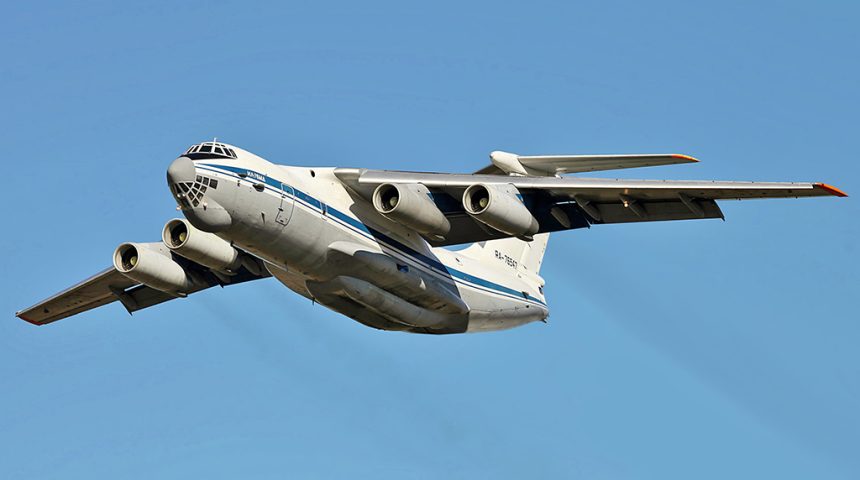Reports Suggest Heavy Resistance to Russian Entry into Ukrainian Capital.
As the sun rises on day three of the Ukrainian war with Russia, reports have surfaced that two Russian Ilyushin Il-76 heavy transports were shot down by Ukrainian air defenses. Russia has not acknowledged the loss of any of its Il-76 aircraft.
On Friday, Feb. 25, 2022, Ukrainian air defenses claimed to have shot down one Russian Il-76 transport near Vasylkiv, south of the capital in Kyiv. Ukrainian reports claimed the aircraft was carrying a “landing force” but did not specify any number of casualties or survivors from the reported incident.
The use of the Il-76 transport aircraft along with specially trained airfield seizure troops similar to U.S. Army Rangers is known as part of Russian military doctrine.
Following reports of this first Il-76 shoot-down incident, a “second Il-76” was reported to have been shot down over Bila Tserkya. The report originated from the Ukrainian State Special Communications Agency. Early reports did not suggest what mission this aircraft may have been performing and no specific reports of casualties or survivors has been provided as of this hour.
Both reports were later confirmed, at around 04.30UTC by AP:
New @AP reporting tonight: Ukrainian President Volodymyr Zelenskyy was asked to evacuate Kyiv at the behest of the U.S. government but turned down the offer. An American official tells me Zelenskyy said, “The fight is here; I need ammunition, not a ride.” pic.twitter.com/oSpa1vdX29
— James LaPorta (@JimLaPorta) February 26, 2022
The Ilyushin Il-76, NATO reporting name “Candid”, is a large, four-engine jet transport roughly similar in mission and configuration to the American C-17 Globemaster III. It is used in a variety of configurations and roles varying from electronic warfare, airborne early warning and control and most commonly, heavy transport including the delivery of airborne forces via parachute insertion and direct landing on captured airfields.
The reports of the Il-76 aircraft being shot down have been accompanied by photos on the internet, both from news agencies and on social media, that show aircraft wreckage. Some components in these photos are identifiable as Il-76 components, most notably, the distinctive tail gun turret in one photo.

However, additional photos of a Ukrainian Il-76 that was shot down by the Russians almost eight years ago on June 14, 2014, have also surfaced in current media reports. The Ukrainian Air Force Il-76 in the 2014 incident was shot down by Russian separatists during its landing approach to Luhansk. In that 2014 incident, 40 soldiers and 9 crew members were killed. That downing took place in June and the landscape in the current photographs seems to be coherent with the summer season. Some social media accounts originating in Ukraine say the two Russian Il-76 shoot-downs claimed today are “revenge” for the 2014 loss of the Ukraine Il-76. Both Ukraine and Russia operate the Ilyushin Il-76 heavy jet transport.
Additional reports suggest that the battle for the capital city of Kyiv has begun, set against the backdrop of a Russian media report from TASS that, “Ukrainian President Vladimir Zelensky has accepted Russian President Vladimir Putin’s proposal and is ready to negotiate peace and a ceasefire.” No other western media outlet has reported this announcement that was attributed to Vladimir Zelensky’s press secretary Sergey Nikiforov.
Further unverified claims of Russian aircraft being downed and repetitive fighting in several areas may suggest that Russian advances are facing heavier resistance than originally estimated, but specific information from either nation in the conflict has been difficult to verify. One report suggested a major thrust by Russian forces into downtown Kyiv using the city’s main road was thwarted by Ukrainian defenders. As with nearly every report coming out of the region, there was no independent verification of the reports.
As the third day of the conflict continues one quandary of this war has been the difficulty of obtaining accurate media information, both from official sources and through social media outlets. In the continued evolution of media in the social media age, the distinction between “official” media outlets and amateur social media has blurred or disappeared entirely. As a result, reports from the region originate from either embedded reporters actually in Ukraine, such as the BBC’s Liz Doucet who has been reporting directly from the Ukrainian capital via satellite and internet links, or from observers outside the region monitoring official news and unofficial social media channels for stories. Even private satellite reconnaissance companies have provided intelligence on the conflict, but with little context and no official verification. These vastly different media resources provide either a very close-up view of the conflict, as if “viewing the battlefield through a straw”, to a very broad and usually less credible perspective gleaned from media surveys that are highly susceptible to misinformation and disinformation. As a result of this highly polarized media depiction of the war, an enormous amount of information between these two journalistic extremes has left worldwide observers in the dark, with few credible, substantial narratives of the conflict to depend on.









